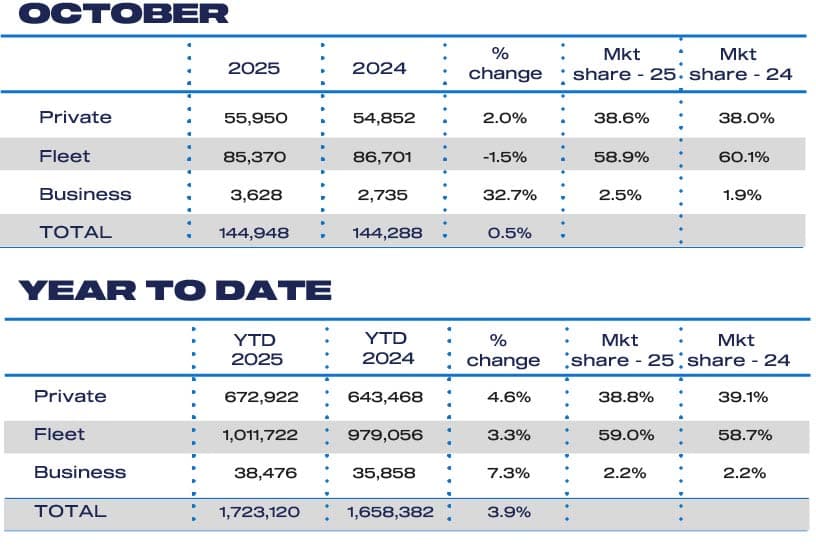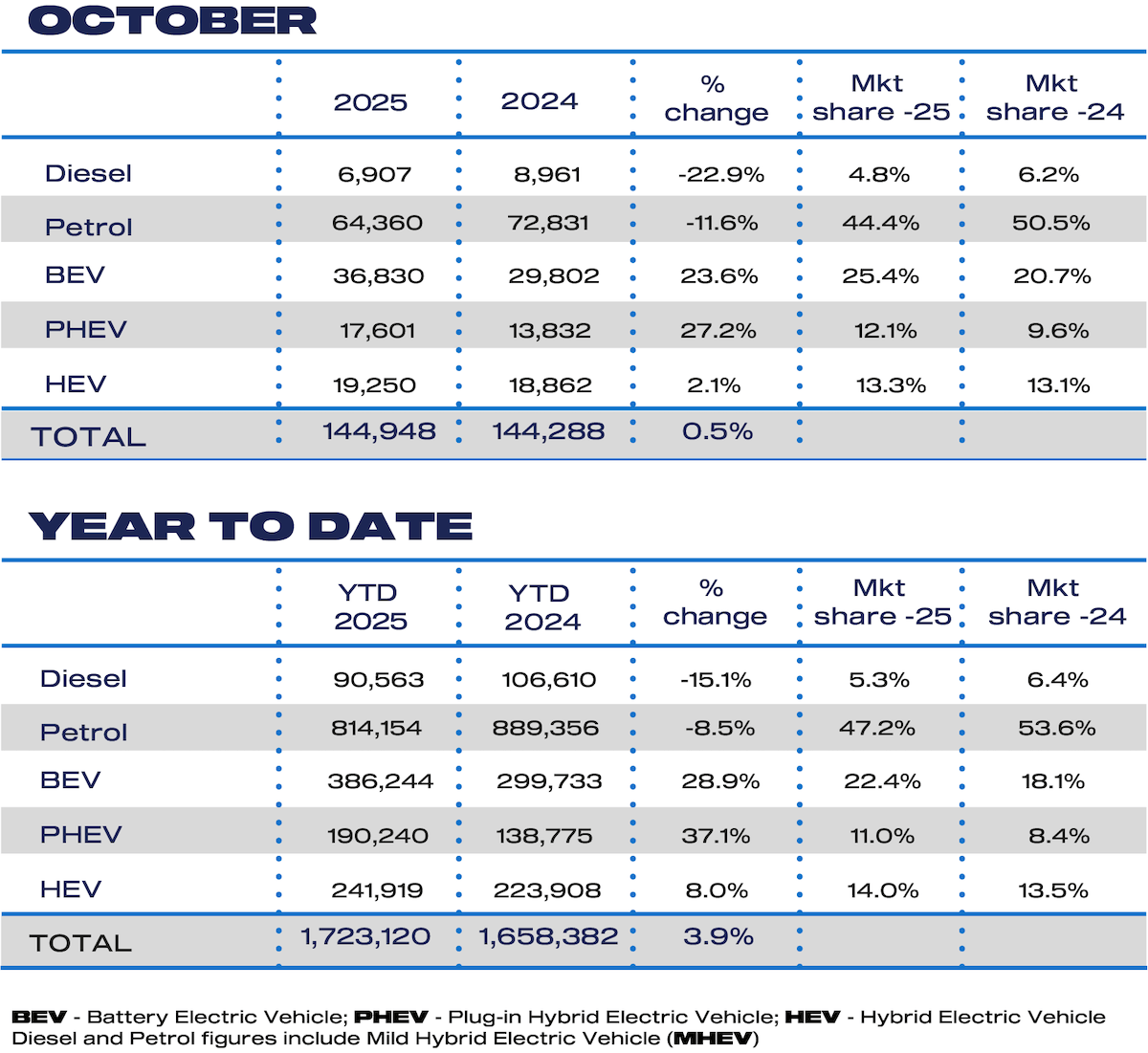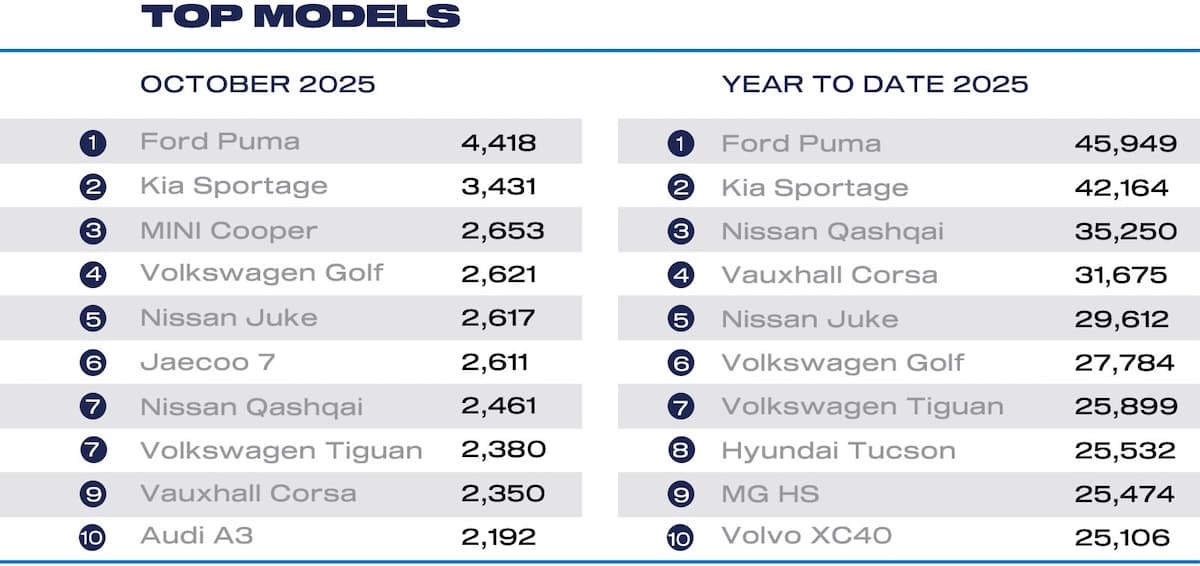October is a stable month for new car sales
New car registrations stabilized in October 2025, with numbers equal to the same month and going back to approximately 2018 (excluding the COVID-19 affected years 2021/2022).
According to registration data published this morning by the Society of Motor Manufacturers and Traders (SMMT), private sales were up 2% compared to the same month last year, while fleet registrations fell by almost the same amount, meaning the overall result was just a 0.5% increase on last October.

Electric and hybrid cars continue to rise in sales
Although headline numbers have been flat, the composition of vehicles sold continues to shift from purely fossil fuel-powered vehicles to electric and hybrid vehicles.
Gasoline car sales fell by 12%, while diesel cars became little more than a footnote in new car data. Gasoline-powered cars are still the largest type of new car sold, but their market share has fallen from 51% to 44%. Electric cars accounted for 25% of the market, an increase of 24% compared to last year, while hybrid cars continued their strong growth over the past 12 months, and regular hybrids also achieved slight growth.
Officially, a market share of 25% in October, and 22% year to date, means EV sales are still below the government's target of 28% for this year. However, by the time the various loopholes and provisions are taken into account, the net target is estimated at around 23%, so the industry is on track to achieve this by the end of the year.
The targets rise to 33% next year, so automakers will have no interest in overachieving them this year. Most are already managing their inventories for the rest of the year to ensure they meet their 2025 goals and carry over any additions to January.

Good month, bad month
Although the overall registration numbers are similar to last year's numbers, there has been significant movement between different car manufacturers.
It's been a good month for Alfa Romeo, Alpine, BYD, Cupra, Dacia, KGM, Omoda, Polestar, Renault, Suzuki and Vauxhall. All of these brands outperformed the overall market by at least 10%.
Meanwhile, numbers fell for Abarth, Bentley, BMW, Citroen, DS Auto, Fiat, Genesis, GWM, Honda, Hyundai, Ineos, Jeep, Kia, Lexus, Mazda, Mercedes-Benz, MG, Peugeot, Porsche, Seat, Skoda, Subaru, Tesla, Toyota, Volkswagen and Volvo.
This means that the following manufacturers were where you would expect them to be: Audi, Ford, Land Rover, Maserati, Mini, Nissan, and Smart - all of whom were +/- 10% in the same month last year.
As usual, Volkswagen was the best-selling brand in the UK in October, increasing its market share despite slightly lower sales. Audi, Ford, BMW and Kia were next, none of which were a big surprise.
The two big Chinese companies, BYD and the Chery Group (Chery, Jaco and Umoda), continue to make strong inroads into the market, putting increasing pressure on struggling European and Japanese brands. 2026 will almost certainly see this pressure reach breaking point for some brands within the industry, as there is still plenty of growth to come from the current push of Chinese brands and others to come.
Ford Puma is close to retaining the sales crown
The Ford Puma was again the UK's best-selling car in October, besting the Kia Sportage - its main rival in the 2025 sales race - by almost 1,000 units. That gives the Puma a huge lead just two months ago, although we've seen big swings in the last two months in recent years, so Ford won't be celebrating just yet (and Kia has a refreshed Sportage now in showrooms).

UK manufacturing had three cars in the top ten, namely the Mini Cooper, Nissan Juke and Nissan Qashqai. The Jaecoo 7 remained on the best-seller list for a second month, while the Audi A3 also made one of its reasonably rare appearances.
We'll take our usual look at the top 10 in the coming days.

